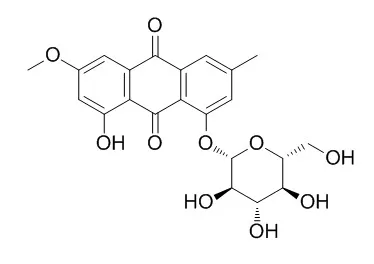| In vitro: |
| Life Sci. 1997;61(23):2335-44. | | A tumor cell growth inhibitor from Polygonum hypoleucum Ohwi.[Pubmed: 9408056 ] | Polygonum hypoleucum Ohwi (P. hypoleucum Ohwi) has been used as a Chinese medicine for a long time. In the present study, four anthraquinones, emodin, emodin 1-O-beta-D-glucoside (49A), physcion (62A), and Physcion 1-O-beta-D-glucoside (50A) were identified from P. hypoleucum Ohwi and their inhibitory effects on various tumor cells proliferation were investigated. On a percentage basis, emodin had the highest suppressing activity on the various tumor cells proliferation.
METHODS AND RESULTS:
At 10 microg/ml, the percentage inhibition on K562 cells proliferation for emodin, 49A, 62A, and 50A were 97+/-3.4%, 18+7.3%, 24+/-3.6%, and 31+/-8.9%, respectively. However, inhibitory activities of 10 microg/ml of emodin, 49A, 62A, or 50A on Raji cells proliferation were 98+/-5.0%, 25+/-5.0%, 22+/-3.2%, and 28+/-4.3%, respectively. It was also found that the both C1 and C3 positions of emodin were important for antitumor action. The IC50s of emodin, 49A, 62A, and 50A on various tumor cells were also calculated. The IC50 of emodin on K562 cells was significantly lower than on Raji, HeLa, Calu-1, Wish, and Vero cells (1.5+/-0.2 vs. 2.8+/-0.4 microg/ml, P < 0.01 ;1.5+/-0.2 vs. 8.4+/-1.6 microg/ml; 1.5+/-0.2 vs. 8.9+/-1.0 microg/ml; 1.5+/-0.2 vs. 8.7+/-0.5 microg/ml; 1.5/-0.2 vs. 3.5+/-0.12 microg/ml; P < 0.001).
CONCLUSIONS:
The results indicated that K562 and Raji cells were more sensitive to emodin treatment. Cell viability test indicated that inhibitory effect of emodin on various tumor cell lines was not through direct cytotoxicity. It suggested P. hypoleucum Ohwi included a tumor cell growth inhibitor. | | J Chem Ecol. 1992 Oct;18(10):1833-40. | | Allelochemicals fromPolygonum sachalinense Fr. Schm. (Polygonaceae).[Pubmed: 24254724 ] |
METHODS AND RESULTS:
The root exudates fromPolygonum sachalinense in a recirculating system significantly inhibited lettuce seedling growth. The rhizomes and roots ofP. sachalinense were extracted with 80% acetone. Bioassay of the neutral-acidic fraction on the TLC agar plate showed the inhibitory activity corresponded to the two yellow pigment bands. Two orange needles were isolated and identified as anthraquinone compounds: emodin and physcion. Both compounds exhibited inhibitory activities against the seedling growth of several testing plant species. Glucosides were isolated fromP. sachalinense and were identified as emodin-1-O-β-D-glucoside and
Physcion 1-O-beta-D-glucoside, respectively. On plant growth bioassay, these glucosides showed no phytotoxic activity against lettuce seedlings. The concentrations of emodin, physcion, and their glucosides from rhizome with roots, aerial parts, fallen leaves, and soil were determined. The rhizome with roots and fallen leaves contained emodin and physcion at relatively high concentrations. Emodin also occurs in the soil of this plant community with effective concentrations in the fall.
CONCLUSIONS:
The results indicate that these anthraquinones are responsible for the observed interference and are potent allelopathic substances. |
|






 Cell. 2018 Jan 11;172(1-2):249-261.e12. doi: 10.1016/j.cell.2017.12.019.IF=36.216(2019)
Cell. 2018 Jan 11;172(1-2):249-261.e12. doi: 10.1016/j.cell.2017.12.019.IF=36.216(2019) Cell Metab. 2020 Mar 3;31(3):534-548.e5. doi: 10.1016/j.cmet.2020.01.002.IF=22.415(2019)
Cell Metab. 2020 Mar 3;31(3):534-548.e5. doi: 10.1016/j.cmet.2020.01.002.IF=22.415(2019) Mol Cell. 2017 Nov 16;68(4):673-685.e6. doi: 10.1016/j.molcel.2017.10.022.IF=14.548(2019)
Mol Cell. 2017 Nov 16;68(4):673-685.e6. doi: 10.1016/j.molcel.2017.10.022.IF=14.548(2019)